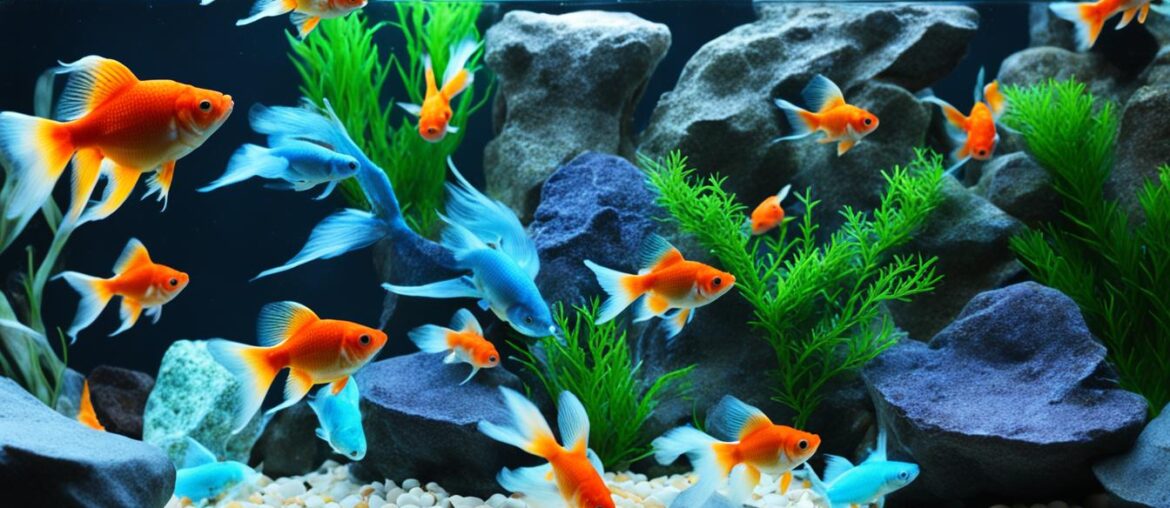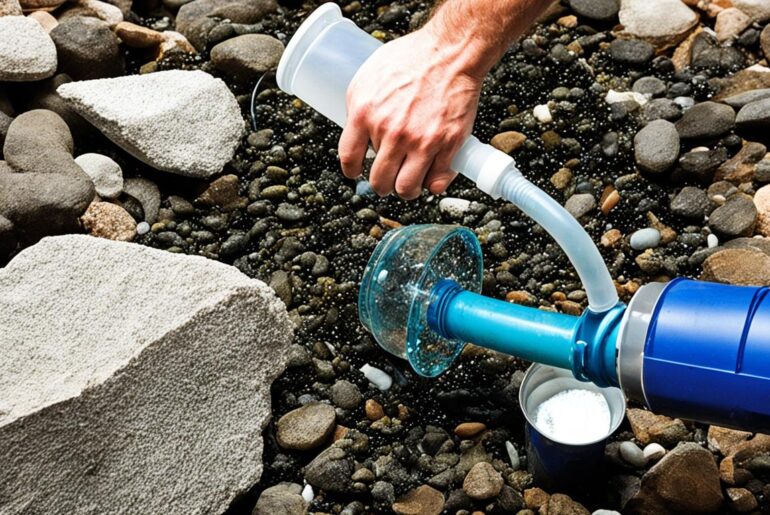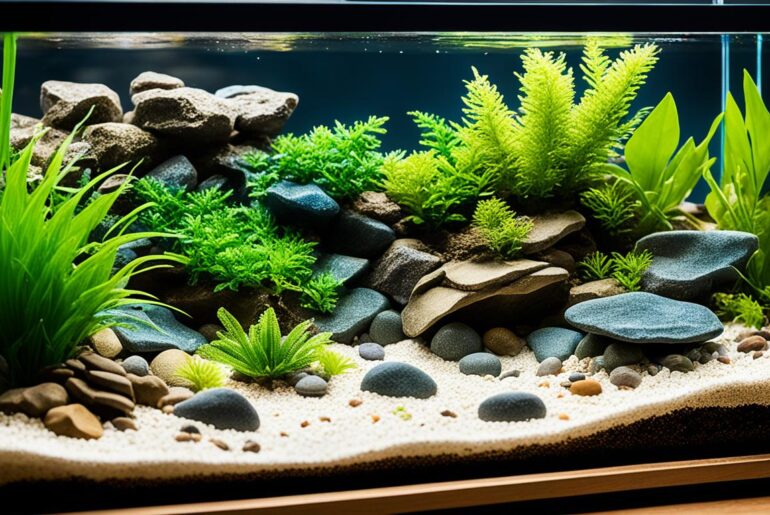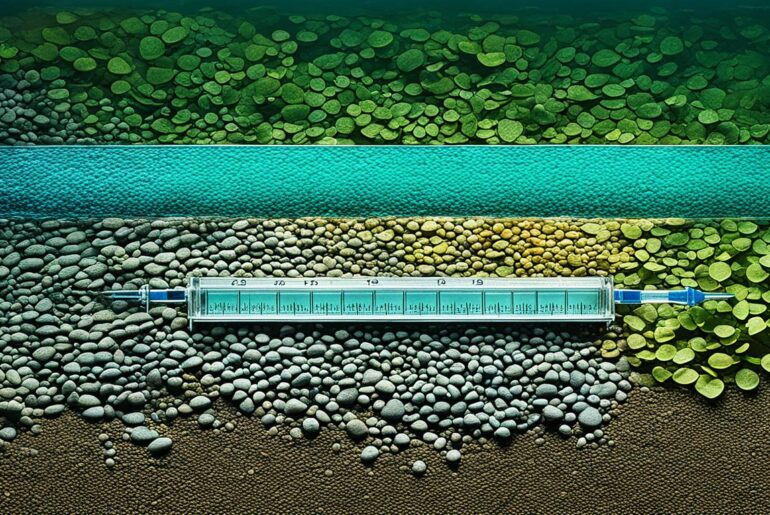When I first decided to set up a freshwater goldfish tank, I was thrilled at the opportunity to create a vibrant and beautiful underwater world. But as I delved into the world of goldfish care, I quickly realized that choosing the right substrate was crucial for the success of my tank.
I wanted to create an environment that would not only be visually appealing but also provide a comfortable and healthy home for my goldfish. After extensive research and trial and error, I discovered the top 10 substrates that are ideal for freshwater goldfish tanks.
Key Takeaways:
- Choosing the right substrate for your goldfish tank is essential for creating a comfortable and healthy environment.
- The best substrate for goldfish tanks depends on factors such as the type of goldfish and the presence of live plants.
- Gravel, sand, and large stones are popular substrate options that provide a natural aesthetic appeal.
- Fancy goldfish require a softer and smoother substrate to prevent injuries.
- An ideal substrate promotes a healthy and vibrant aquarium environment for your goldfish.
Do goldfish need substrate?
Goldfish do not actually need substrate in their tank, and they can live healthily without it. However, there are benefits and potential problems associated with having a bare bottom tank.
A bare tank makes cleaning easier and reduces the risk of waste buildup. Without substrate, waste can be easily vacuumed or siphoned from the tank, maintaining a cleaner and healthier environment for the goldfish. Additionally, a bare tank allows for easy observation of the goldfish’s waste, which can help with monitoring their digestive health.
On the other hand, a goldfish tank without substrate may look unfinished. The bare bottom can appear stark and less aesthetically pleasing compared to tanks with substrate. Substrate can also provide a more natural and realistic environment for the goldfish, mimicking their natural habitat. It can create a visually appealing backdrop for plants, decorations, and the goldfish themselves.
Another consideration is that substrate supports the growth of live plants in the tank. Plants can enhance the water quality by absorbing excess nutrients and providing oxygen. However, without substrate, planting live plants can be challenging or even impossible, limiting the options for aquascaping and the potential benefits of having live plants in the tank.
Ultimately, the decision to have substrate or not depends on personal preference and the specific needs of the goldfish and the tank setup. Some goldfish keepers prefer a bare bottom tank for ease of maintenance and observation, while others prefer a more natural-looking environment with substrate. It’s important to consider the advantages and disadvantages and choose what best suits your goals and the well-being of your goldfish.
Gravel for goldfish tanks
Gravel is a popular choice when it comes to selecting substrate for goldfish tanks. Not only does it provide a natural aesthetic appeal, but it also offers several benefits for both the fish and the overall tank environment. When considering gravel for your goldfish tank, there are a few important factors to keep in mind.
Types of Gravel for Goldfish Tanks
Goldfish tank gravel comes in various sizes and colors, allowing you to customize the look of your aquarium. From small pebbles to larger stones, there is a wide range of options to choose from. However, it is crucial to select a type of gravel specifically designed for fish tanks to ensure the safety and well-being of your goldfish.
Adding Gravel to Your Goldfish Tank
Before adding gravel to your goldfish tank, it is important to rinse it thoroughly to remove any dust or debris. This will help maintain the water quality and prevent any potential harm to your fish. Once rinsed, carefully spread the gravel across the tank’s bottom, creating an even layer. It is recommended to have a depth of approximately 1-2 inches for optimal coverage.
Cleaning a Gravel Substrate
Regular cleaning is essential to maintain the cleanliness of the gravel substrate in your goldfish tank. One effective method is using a siphon to remove any debris or waste that has settled between the gravel. This will prevent the accumulation of harmful substances and help keep the water quality at its best. It is advisable to perform partial water changes in conjunction with gravel cleaning to ensure a healthy and balanced environment for your goldfish.
In conclusion, gravel is a popular and versatile substrate choice for goldfish tanks. It provides a natural aesthetic appeal while offering important benefits for your goldfish. Just remember to select fish tank-specific gravel and rinse it thoroughly before adding it to your tank. Regular cleaning with a siphon will help maintain the cleanliness of the gravel substrate, promoting a healthy and thriving goldfish tank.
Sand substrate for goldfish
Sand is another option for goldfish tank substrate. It offers several benefits and adds a unique touch to the tank’s design. With different grain sizes and colors available, sand allows for customization and creativity in creating a natural and visually appealing environment for your goldfish. Adding sand to your goldfish tank provides an opportunity for your fish to engage in their natural behaviors, such as digging and foraging.
When incorporating sand into your goldfish tank, it’s essential to prepare it properly. Before adding sand to the tank, it should be rinsed thoroughly to remove any impurities or dust. This step ensures that the sand substrate is clean and safe for your goldfish.
Regular maintenance of a sand substrate involves gently stirring the sand to prevent gas buildup, which can occur in the substrate over time. By doing so, you help to maintain a healthy and oxygen-rich environment in the tank.
Adding sand to your goldfish tank not only enhances its aesthetic appeal but also provides a comfortable and natural environment for your goldfish to thrive. However, it’s important to note that sand may not be suitable for all goldfish species, so it’s recommended to research and consider the specific needs of your goldfish before making a decision.
| Benefits of sand substrate for goldfish tanks |
|---|
| Provides a natural and visually appealing environment |
| Allows for digging and foraging behavior |
| Can be customized with different grain sizes and colors |
| Easy to clean and maintain with regular gentle stirrings |
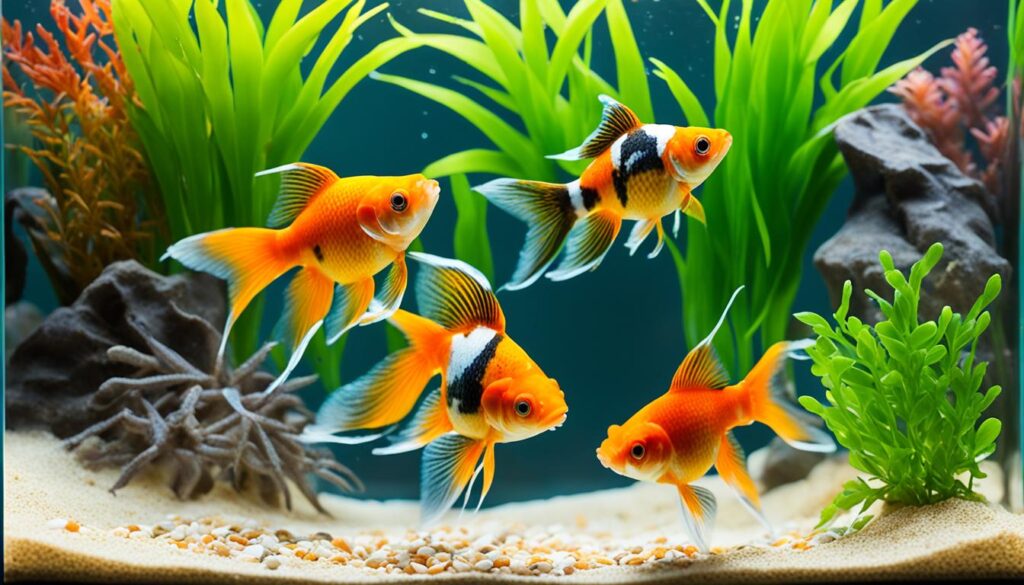
Large stones and pebbles
Looking to create a unique and natural appearance in your goldfish tank? Consider adding large stones and pebbles as substrate. Not only do they provide a solid surface for goldfish to swim and rest on, but they also add an interesting visual element to your aquarium.
When adding stones and pebbles to your goldfish tank, it’s important to ensure they are properly cleaned. Rinse them thoroughly to remove any dirt or debris that may be present. This helps maintain the cleanliness of your tank and ensures a healthy environment for your goldfish.
Regular cleaning is also essential when using stones and pebbles as substrate. Take the time to remove any waste or algae buildup on the stones and pebbles. This will help keep your tank looking pristine and prevent any potential issues that may arise from neglecting maintenance.
| Benefits of using large stones and pebbles as substrate: |
|---|
| 1. Unique and natural appearance |
| 2. Provides a solid surface for goldfish to swim and rest on |
| 3. Adds visual interest to your aquarium |
The Best Substrate for Fancy Goldfish
Fancy goldfish require special care, including the choice of substrate for their tank. Due to their delicate fins and increased susceptibility to diseases, it is crucial to select a substrate that is soft and smooth, preventing any potential injuries. The right substrate will provide a comfortable and safe environment for your fancy goldfish to thrive.
The generally recommended substrates for fancy goldfish tanks are fine gravel or sand. These options offer a cushioning and gentle surface for your goldfish, minimizing the risk of fin damage. Additionally, fine gravel and sand are smoother compared to larger substrates, reducing the chance of injury to your goldfish’s delicate fins.
When choosing a substrate for your fancy goldfish tank, it is important to ensure that it does not pose a choking hazard. Avoid substrates with small particles that the goldfish could accidentally ingest, as this can lead to serious health issues. It is always better to prioritize the safety and well-being of your goldfish by opting for substrates specifically recommended for fancy goldfish tanks.
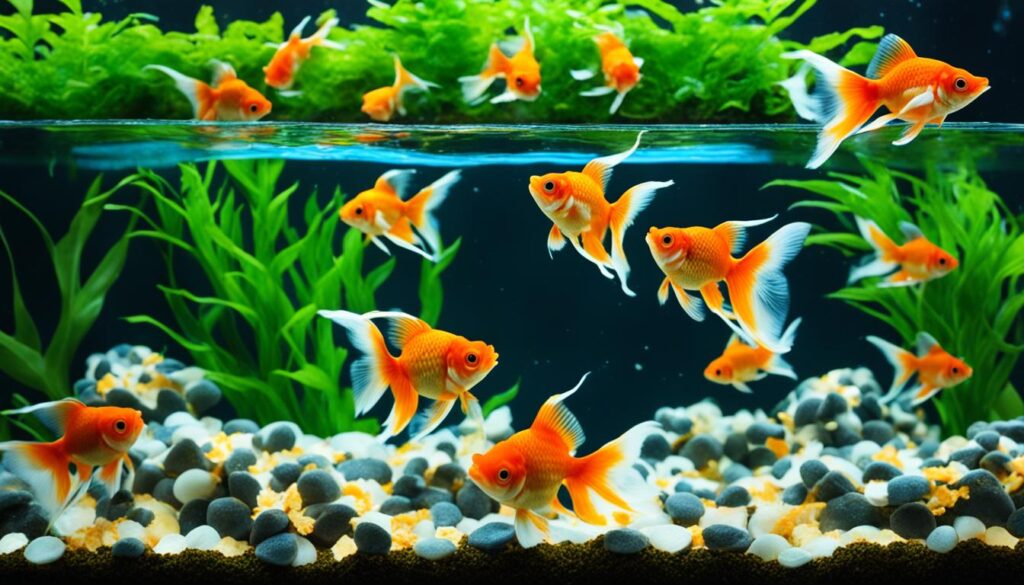
“The right substrate for your fancy goldfish tank can significantly impact the health and well-being of your goldfish. Choose a substrate that is soft, smooth, and free from potential hazards, ensuring a comfortable and safe habitat for your elegant companions.”
Similar Goldfish Tank Posts
If you are interested in learning more about goldfish tank substrates, there are many other articles and resources available online. These resources provide additional information and insights into the different types of substrates available, how to choose the right one, and tips for maintaining a healthy goldfish tank.
Here are some related goldfish tank articles that you may find helpful:
- The Importance of Choosing the Right Substrate for Your Goldfish Tank
- A Guide to Different Types of Substrates for Freshwater Goldfish Tanks
- Maintaining a Clean and Healthy Goldfish Tank with the Right Substrate
- Pros and Cons of Various Goldfish Tank Substrates
These articles offer valuable insights and expert advice to help you make informed decisions when it comes to selecting the best substrate for your goldfish tank. Whether you are a beginner or an experienced goldfish keeper, exploring these resources will expand your knowledge and enhance your goldfish keeping experience.

Conclusion
Choosing the best substrate for a freshwater goldfish tank is a personal decision that depends on various factors such as the type of goldfish, your preferences, and the setup of your tank. After reviewing the options available, I have found that gravel, sand, large stones, and pebbles are the most popular substrates for goldfish tanks.
Gravel provides a natural aesthetic appeal and allows for easy cleaning with a siphon. Sand is another great option that allows for goldfish to exhibit their natural behavior of digging and foraging. Large stones and pebbles not only create a unique and natural appearance but also provide a solid surface for goldfish to swim and rest on.
However, if you have fancy goldfish with delicate fins, it is important to choose a substrate that is soft and smooth to prevent any injuries. Fine gravel or sand substrates are generally recommended for fancy goldfish tanks. Always make sure that the chosen substrate meets the specific needs of your goldfish and promotes a healthy and vibrant aquarium environment.
In conclusion, there is no one-size-fits-all answer to the best substrate for goldfish tanks. It ultimately comes down to your personal preference and the needs of your goldfish. Consider the type of goldfish, aesthetic appeal, ease of cleaning, and the behavior you want to promote. By selecting the right substrate, you can create a beautiful and thriving freshwater goldfish tank.
FAQ
Do goldfish need substrate?
Goldfish do not actually need substrate in their tank, but it can have benefits and potential problems. The decision to have substrate or not depends on personal preference and the specific needs of the goldfish and the tank setup.
What are the benefits of a bare goldfish tank base?
A bare tank makes cleaning easier and reduces the risk of waste buildup.
What are the potential problems with a bare base?
A bare tank may look unfinished and can limit the growth of plants.
What type of gravel is suitable for goldfish tanks?
Gravel specifically designed for fish tanks is suitable for goldfish tanks.
How do I add gravel to a goldfish tank?
Gravel should be rinsed thoroughly before adding it to the tank to remove any dust or debris.
How do I clean a gravel substrate?
Regular cleaning with a siphon is necessary to maintain the cleanliness of the gravel substrate.
What are the benefits of using sand as substrate for goldfish tanks?
Sand provides a natural environment for goldfish and allows for digging and foraging behavior.
How do I add sand to a goldfish tank?
Sand should be rinsed thoroughly to remove any impurities before adding it to the tank.
How do I clean a sand substrate?
Regular maintenance includes gently stirring the sand to prevent gas buildup.
How do I add large stones and pebbles to a goldfish tank?
Stones and pebbles should be rinsed thoroughly before adding them to the tank to remove any dirt or debris.
How do I clean stones and pebbles in a goldfish tank?
Regular cleaning includes removing any waste or algae buildup on the stones and pebbles.
What is the best substrate for fancy goldfish?
Fine gravel or sand substrates are generally recommended for fancy goldfish tanks.
Why do fancy goldfish require a specific substrate?
Fancy goldfish have delicate fins and are more prone to diseases, so it is important to choose a substrate that is soft and smooth to prevent any injuries.
Where can I find more information about goldfish tank substrates?
There are many other articles and resources available online that provide additional information and insights into the different types of substrates available, how to choose the right one, and tips for maintaining a healthy goldfish tank.
What are some similar goldfish tank posts I can read?
You can find more articles about goldfish tank substrates and related topics by exploring other posts and resources available online.
What is the conclusion on the best substrate for goldfish tanks?
Choosing the best substrate for a freshwater goldfish tank is a personal decision that depends on various factors such as the type of goldfish, preferences, and tank setup. Gravel, sand, large stones, and pebbles are popular options that provide a natural aesthetic appeal and support goldfish behavior. The best substrate for fancy goldfish may differ as they require a softer and smoother substrate. Ultimately, it is essential to consider the specific needs and preferences of the goldfish and ensure that the chosen substrate promotes a healthy and vibrant aquarium environment.
